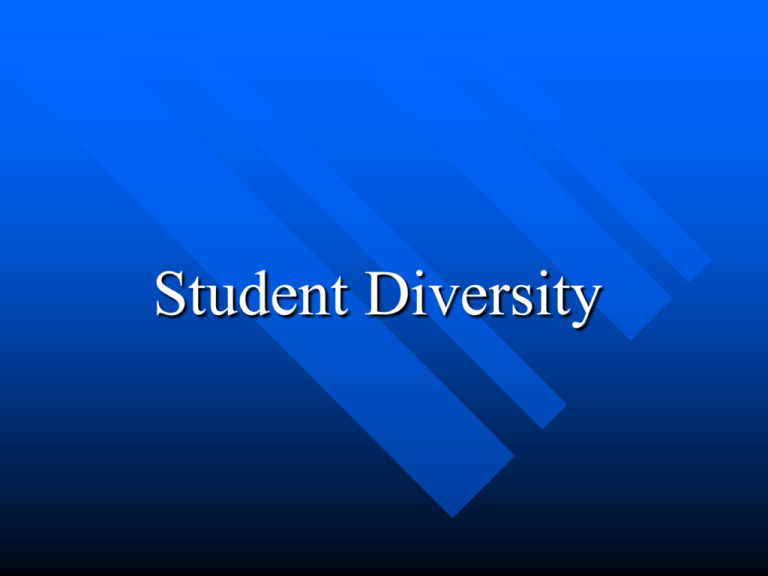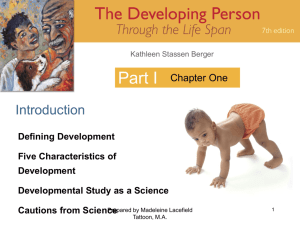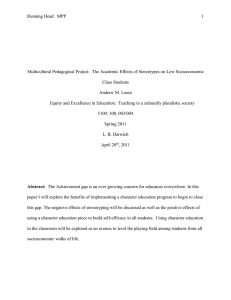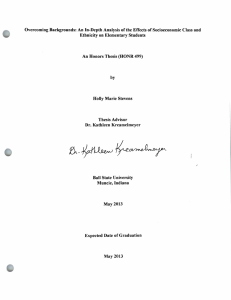Educational Psychology: Theory and Practice Chapter 4
advertisement

Student Diversity Student Diversity In what ways are students diverse? Impact of Culture Norms Traditions Behaviors Language Perceptions SHARED TB: But, I bearly know U. The internet has helped to break down some cultural barriers. Who Am I? Write the top three answers that come to your mind. Macroculture European American Asian/Pacific Islander American Indian Shared National American Culture Hispanic African American Percentages of U.S. Population by Race/Ethnicity Race/Ethnicity 2000 2006 2010 (1995 Projections) European American 71.4 73.9 (67.4) Hispanic 11.9 14.8 (14.6) African American 12.2 12.4 (12.5) Asian/Hawaiian/Pacific Islander 3.8 4.5 (4.8) American Indian 0.7 0.8 (0.8) Source: http://factfinder.census.gov Socioeconomic Status Definition Disadvantages of Low SES Role of Child-Rearing Practices – – – – – Parents are less educated role models Inconsistent parenting Less value on creativity More Punishment Kinds of Parent-Child Activities differ Link Between Income and Summer Learning Possible Conflicts Between School and Cultural Expectations High and Low Power Distance Cultures High Low Powerful Elite Upper Class Large Middle Class Majority Lower Economic Class Source: Eric Law 1993 Socioeconomic Status Role of Schools As Middle-Class Institutions School Values Individuality Future Time Orientation Competition Control of Nature Cherish Freedom Mismatched Values Group Loyalty Focus on Present Cooperation Respect and Live with Nature Cherish Tradition School and Community Factors - Funding - Desegregation Ethnicity and Race Why Have Minority-Group Students Lagged in Achievement? – – – – Socioeconomic Status Inferior Schools Instruction Inconsistent with Culture Low Expectations Bilingual Programs Bilingual Education – Advantages » Self Esteem » School Achievement Is Not Dependent On Language Skills » Increased Achievement – Disadvantages » Not Enough Bilingual Teachers » Re-segregates Students Gender and Gender Bias Assessments The Maccoby and Jacklin Study – Differences Within Sexes Exceeded Differences Between Sexes – Experimenters Could Not Control Sex Assignment – Only Four Consistent Differences Were Found Gender and Gender Bias The Maccoby and Jacklin Study Results & Updates – – – – Verbal Visual-Spatial Math Aggressiveness Sexism at Home • Expectations • Reinforcements Sexism in the Classroom • Observations • Communication • Teacher Chivalry • Conclusions Percentage of Males and Females who Enrolled in and Completed High School Courses Courses Algebra Trigonometry or Geometry Chemistry or Physics English, 3 Years or More Foreign Language, 2 Years or more Percent Males Completing 81.6 Percent Females Completing 76.8 60.1 50.3 54.2 42.3 92.8 94.1 39.1 48.1 Learning Styles Theories of Learning Styles – Different Ways of Learning – Field Dependence versus Field Independence (Embedded Figures) – Impulsive versus Reflective – Learning Environment Preference










